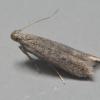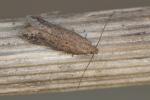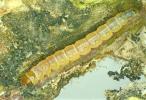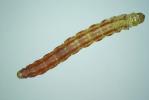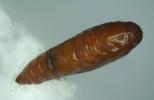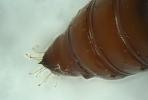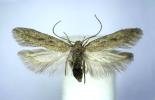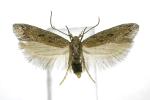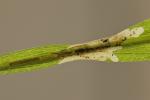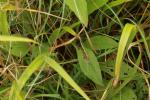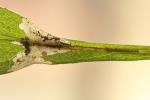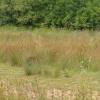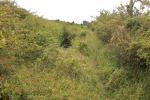35.110 Scrobipalpa freyii (Scott, 1859)
Status and Distribution
Scrobipalpa pauperella renamed S. freyii - details in Beavan & Heckford, 2024 (see full reference under S. freyii in Publications - Published Papers).
Rare. Recorded at a few well scattered sites in England.
First discovered in Britain in 1858 in the Middlesborough area. Not reported again until 1972 and 1973 at Chippenham Fen NNR, Cambridgeshire. Since then, all searches for the larvae and adults at this site have proved negative.
Rediscovered, when attracted to light in mid-West Yorkshire (VC64) from 2011 onwards, although this was initially thought to refer to S. obsoletella. Specimens were critically re-examined in late 2013 and found to refer to S. pauperella (now renamed S. freyii). The number of moths found over subsequent years (c30 to late 2015) meant the moth was resident at this site, but several searches for larvae have drawn a blank.
In July 2018 a photograph seen on the Dissection Group website of the male genitalia of a Scrobipalpa from Ashridge Estate, Bucks (VC24) on 18th June 2013, and identified as S. obsoletella, was thought likely to refer to S. pauperella, which was subsequently confirmed. This site has since been revisited (in 2023) where larvae were found and bred on Centaurea nigra (sensu lato).
On 24 August 2022, a considerable number of tenanted mines were found on Centaurea scabiosa (greater knapweed) leaves in Dover, Kent, with subsequent breeding confirming them to be S. freyii.
There is some similarity between the variable forewing markings of both S. acuminatella and S. freyii. It would therefore be worth considering closer examination of light trapped or netted specimens of S. acuminatella found in chalky areas.
.jpg)
Provisional map
Foodplant and Larval Feeding Signs
Centaurea scabiosa (greater knapweed) in Britain.
The larva intially makes a short narrow mine along the midrib of the leaf on the upperside, often then forming a diverticulum beside a vein, with black frass extruded from the end of the mine along the midrib. The mine is gradually widened either side of the midrib, eventually forming blotches, within which frass is deposited. The outer edges of the affected leaves often turn slightly upwards.
In Europe, as well as being associated with C. scabiosa, other species of Asteraceae (Compositae), such as Cirsium palustre (marsh thistle), Cirsium helenioides, Petatsites albus (white butterbur) and Serratula (saw-wort) are also utilised. It mines along the midrib of the leaves in Cirsium palustre.
Larvae on Cirsium palustre collected during searches for this species at Chippenham Fen produced only Scrobipalpa acuminatella and no Centaurea scabiosa was found anywhere near the 1972/3 capture site. Similarly in Yorkshire, C. scabiosa is absent from this site, while Cirsium palustre is locally common. Tenanted mines on the latter plant here have only produced Scrobipalpa acuminatella.
In 2022, many larvae were found in Kent on C. scabiosa, with some bred, and in Buckinghamshire in 2023 larvae (some subsequently bred) were found on C. nigra (s.l.). Due to difficulties in the separation of C. nigra (common knapweed) from C. debeauxii (chalk knapweed) the plants utilised may relate to either of these species or intermediate hybrids.
Habitat
The habitat at the Cambridgeshire site is fenland, while the Yorkshire site is an area of mature mixed woodland with large open clearings of herb rich magnesian grassland containing several small ponds. The moths in Yorkshire were light trapped near one of the wetter parts of the site. In Kent, the site comprises open, coastal chalk cliffs where it utilises greater knapweed plants with few leaves.
Finding the Moth
Larva: fenland areas in Cambridgeshire where the possible larval foodplant, marsh thistle, occurs would be worth further investigation. Checks at the Yorkshire have failed to turn up any signs of larval feeding so far. Those found in Kent favoured plants with less luxuriant growth and only a few leaves, many of the leaves used growing fairly close to the chalk substrate.
Adult: in Europe the moth has been noted flying about marsh thistle.
Similar Species
The British specimens found and bred to date closely resemble Scrobipalpa acuminatella and always require dissection for confirmation. In Europe, the forewing colour of S. freyii varies from nearly fuscous to more or less orange brown depending on the ammount of orange scales. If S. freyii is suspected, retention and dissection of a voucher specimen from the original or any new site is considered essential.
Single-brooded, from late May to early July. In Central Europe it appears to be bivoltine with records from April to early June and again in July and August.

